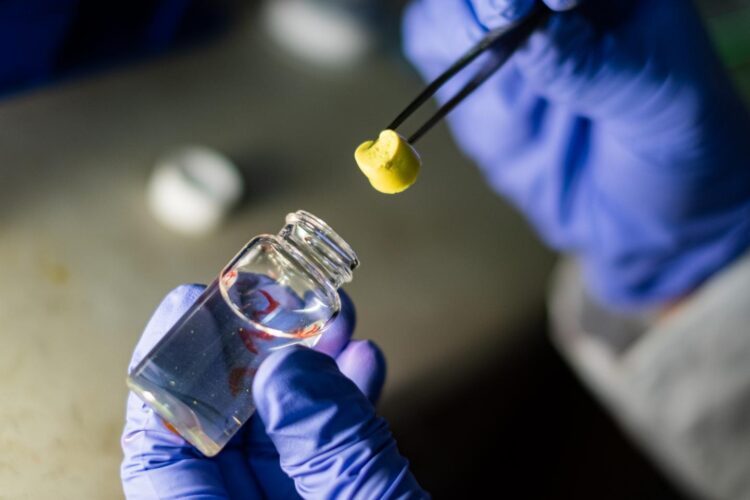Rice lab creates spongelike materials for environmental remediation and more
HOUSTON – (June 8, 2021) – A simple chemical process developed at Rice University creates light and highly absorbent aerogels that can take a beating.
Covalent organic frameworks (COFs), crystal structures with strong molecular bonds, can form a porous aerogel for use as a custom membrane in batteries or other devices or as an absorbent to remove pollutants from the environment.
Conventional COFs are usually powders. Chemical and biomolecular engineer Rafael Verduzco, lead authors and Rice graduate students Dongyang Zhu and Yifan Zhu and their colleagues at Rice’s Brown School of Engineering discovered a way to synthesize COF aerogels that can be made in any form at any size, limited only by the reaction chamber.
The process reported in the American Chemical Society’s Chemistry of Materials employs COF monomers, a solvent and a catalyst. When mixed and heated to 80 degrees Celsius (176 degrees Fahrenheit), they become a uniform gel. Washing and drying the gel to remove the solvent leaves behind the scaffoldlike aerogel with pores between 20 and 100 microns.
“The big advantage of polymers is that you can dissolve them in a solvent, you can spray coat, spin coat and dip coat them, and they’re easy and cheap to work with,” Verduzco said. “But COFs are not. They’re an insoluble powder and hard to do anything with, but they are really promising for applications because you can design or engineer them almost any way you want on the molecular level. They’re like Lego blocks and you can pick the molecular shapes, sizes and characteristics you’d like to include in the final material.
“We were looking for ways to make COFs easier to work with, more like polymers, and we found that under particular reaction conditions they would form a gel,” he said. “When you extract the solvent, you get this very light foam, or aerogel.”
Verduzco said COF aerogels could be a valuable addition to industrial absorbents now in use for remediation because their porous structures can be customized.
The lab formulated six aerogels and found their remediation properties with various dyes, oils and gold nanoparticles were far better and faster than COF powders. In a test with iodine vapor, a product of nuclear fission, the aerogel absorbed 7.7 grams of iodine per gram of aerogel, significantly better than a COF powder of the same material.
The researchers found the aerogels could be washed and reused at least 10 times without deforming. “They’re pretty soft but you can squish them by hand and they spring back,” Verduzco said.
He sees even greater potential for COFs as membranes to separate components in advanced batteries, the subject of a recent review paper led by Dongyang Zhu in Advanced Functional Materials.
They could also mimic biological membranes. “Nobody’s figured out how to efficiently separate a mixture of ions or molecules that are about the same size and shape, but with this class of materials, we can precisely control the pore sizes and shapes,” Verduzco said.
“Biological membranes separate ions of the same size and charge through small changes in pore functionality that preferentially bind one ion or the other,” he said. “I think we can start to make synthetic materials that have similar properties.”
The lab is developing a library of COF aerogels to test in applications. “There’s really a lot to explore here,” Verduzco said.
###
Co-authors of the paper are Rice undergraduate Qianqian Yan, graduate students Morgan Barnes, Fangxin Liu, Nicholas Tjahjono, Po-Chun Huang and Chia-Ping Tseng, postdoctoral researcher Pingfeng Yu, research scientist Muhammad Rahman, adjunct professor Eilaf Egap and Pulickel Ajayan, chair of the Department of Materials Science and NanoEngineering, the Benjamin M. and Mary Greenwood Anderson Professor in Engineering and a professor of chemistry. Verduzco is a professor of chemical and biomolecular engineering and of materials science and nanoengineering.
The Army Research Laboratory and the Welch Foundation for Chemical Research supported the research.
Read the abstract at https:/
This news release can be found online at https:/
Related materials:
Covalent organic frameworks for batteries: https:/
Verduzco Laboratory: http://verduzcolab.
Department of Chemical and Biomolecular Engineering: https:/
Department of Materials Science and NanoEngineering: https:/
George R. Brown School of Engineering: https:/
Video:
https:/
Images for download:
https:/
https:/
https:/
Located on a 300-acre forested campus in Houston, Rice University is consistently ranked among the nation’s top 20 universities by U.S. News & World Report. Rice has highly respected schools of Architecture, Business, Continuing Studies, Engineering, Humanities, Music, Natural Sciences and Social Sciences and is home to the Baker Institute for Public Policy. With 3,978 undergraduates and 3,192 graduate students, Rice’s undergraduate student-to-faculty ratio is just under 6-to-1. Its residential college system builds close-knit communities and lifelong friendships, just one reason why Rice is ranked No. 1 for lots of race/class interaction and No. 1 for quality of life by the Princeton Review. Rice is also rated as a best value among private universities by Kiplinger’s Personal Finance.
Media Contact
Jeff Falk
[email protected]
Original Source
https:/
Related Journal Article
http://dx.





